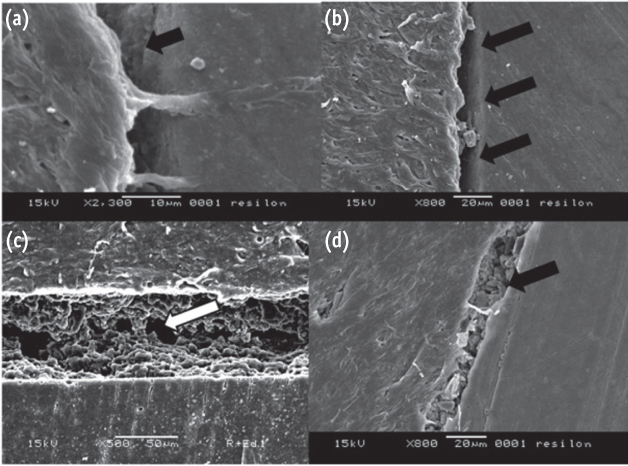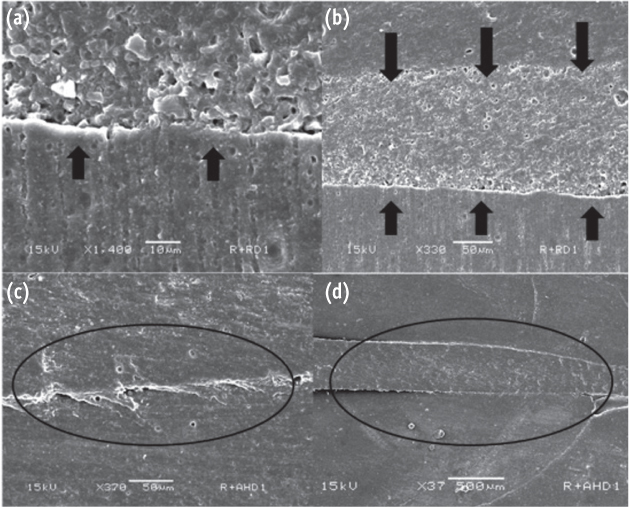Restor Dent Endod.
2014 Nov;39(4):282-287. 10.5395/rde.2014.39.4.282.
Push-out bond strength of a self-adhesive resin cement used as endodontic sealer
- Affiliations
-
- 1Department of Endodontics, School of Dentistry, University of Fortaleza, Fortaleza, Brazil.
- 2Department of Endodontics, School of Dentistry, Federal University of Ceara, Fortaleza, Brazil.
- 3Department of Endodontics, School of Dentistry, State University of Rio de Janeiro, Rio de Janeiro, Brazil.
- 4Department of Endodontics, Health Sciences Center, Grande Rio University, Rio de Janeiro, Brazil. nogueiraemmanuel@hotmail.com
- KMID: 2316909
- DOI: http://doi.org/10.5395/rde.2014.39.4.282
Abstract
OBJECTIVES
The aim of the present study was to investigate the bond strength of RelyX Unicem (3M) to root canal dentin when used as an endodontic sealer.
MATERIALS AND METHODS
Samples of 24 single-rooted teeth were prepared with Gates Glidden drills and K3 files. After that, the roots were randomly assigned to three experimental groups (n = 8) according to the filling material, (1) AH Plus (Dentsply De Trey GmbH)/Gutta-Percha cone; (2) Epiphany SE (Pentron)/Resilon cone; (3) RelyX Unicem/Gutta-Percha cone. All roots were filled using a single cone technique associated to vertical condensation. After the filling procedures, each tooth was prepared for a push-out bond strenght test by cutting 1 mm-thick root slices. Loading was performed on a universal testing machine at a speed of 0.5 mm/min. One-way analysis of variance and Tukey test for multiple comparisons were used to compare the results among the experimental groups.
RESULTS
Epiphany SE/Resilon showed significantly lower push-out bond strength than both AH Plus/Gutta-Percha and RelyX Unicem/Gutta-Percha (p < 0.05). There was no significant difference in bond strength between AH Plus/Gutta-Percha and RelyX Unicem/Gutta-Percha (p > 0.05).
CONCLUSIONS
Under the present in vitro conditions, bond strength to root dentin promoted by RelyX Unicem was similar to AH Plus. Epiphany SE/Resilon resulted in lower bond strength values when compared to both materials.
MeSH Terms
Figure
Reference
-
1. Ozcan E, Eldeniz AÜ, Aydinbelge HA. Assessment of the sealing abilities of several root canal sealers and filling methods. Acta Odontol Scand. 2013; 71:1362–1369.
Article2. Tagger M, Tagger E, Tjan AH, Bakland LK. Measurement of adhesion of endodontic sealers to dentin. J Endod. 2002; 28:351–354.
Article3. Silva EJ, Rosa TP, Herrera DR, Jacinto RC, Gomes BP, Zaia AA. Evaluation of cytotoxicity and physicochemical properties of calcium silicate-based endodontic sealer MTA Fillapex. J Endod. 2013; 39:274–277.
Article4. Resende LM, Rached-Junior FJ, Versiani MA, Souza-Gabriel AE, Miranda CE, Silva-Sousa YT, Sousa Neto MD. A comparative study of physicochemical properties of AH Plus, Epiphany, and Epiphany SE root canal sealers. Int Endod J. 2009; 42:785–793.
Article5. Nakabayashi N. Bonding of restorative materials to dentine: the present status in Japan. Int Dent J. 1985; 35:145–154.6. Leonard JE, Gutmann JL, Guo IY. Apical and coronal seal of roots obturated with a dentine bonding agent and resin. Int Endod J. 1996; 29:76–83.
Article7. Ahlberg KM, Tay WM. A methacrylate-based cement used as a root canal sealer. Int Endod J. 1998; 31:15–21.
Article8. Gogos C, Stavrianos C, Kolokouris I, Papadoyannis I, Economides N. Shear bond strength of AH-26 root canal sealer to dentine using three dentine bonding agents. J Dent. 2003; 31:321–326.
Article9. Zidan O, ElDeeb ME. The use of a dentinal bonding agent as a root canal sealer. J Endod. 1985; 11:176–178.
Article10. Maltezos C, Glickman GN, Ezzo P, He J. Comparison of the sealing of Resilon, Pro Root MTA, and Super-EBA as root-end filling materials: a bacterial leakage study. J Endod. 2006; 32:324–327.
Article11. Shipper G, Teixeira FB, Arnold RR, Trope M. Periapical inflammation after coronal microbial inoculation of dog roots filled with gutta-percha or resilon. J Endod. 2005; 31:91–96.
Article12. Shipper G, Ørstavik D, Teixeira FB, Trope M. An evaluation of microbial leakage in roots filled with a thermoplastic synthetic polymer-based root canal filling material (Resilon). J Endod. 2004; 30:342–347.
Article13. Babb BR, Loushine RJ, Bryan TE, Ames JM, Causey MS, Kim J, Kim YK, Weller RN, Pashley DH, Tay FR. Bonding of self-adhesive (self-etching) root canal sealers to radicular dentin. J Endod. 2009; 35:578–582.
Article14. Kim YK, Grandini S, Ames JM, Gu LS, Kim SK, Pashley DH, Gutmann JL, Tay FR. Critical review on methacrylate resin-based root canal sealers. J Endod. 2010; 36:383–399.
Article15. Gerth HU, Dammaschke T, Züchner H, Schäfer E. Chemical analysis and bonding reaction of RelyX Unicem and Bifix composites-a comparative study. Dent Mater. 2006; 22:934–941.
Article16. Carvalho RM, Pegoraro TA, Tay FR, Pegoraro LF, Silva NR, Pashley DH. Adhesive permeability affects coupling of resin cements that utilise self-etching primers to dentine. J Dent. 2004; 32:55–65.
Article17. Ozturk N, Aykent F. Dentin bond strengths of two ceramic inlay systems after cementation with three different techniques and one bonding system. J Prosthet Dent. 2003; 89:275–281.
Article18. Mota CS, Demarco FF, Camacho GB, Powers JM. Tensile bond strength of four resin luting agents bonded to bovine enamel and dentin. J Prosthet Dent. 2003; 89:558–564.
Article19. Nikaido T, Cho E, Nakajima M, Tashiro H, Toba S, Burrow MF, Tagami J. Tensile bond strengths of resin cements to bovine dentin using resin coating. Am J Dent. 2003; 16 Spec No:41A–46A.20. Ardizzoni A, Generali L, Righi E, Baschieri MC, Cavani F, Manca L, Lugli E, Migliarese L, Blasi E, Neglia RG. Differential efficacy of endodontic obturation procedures: an ex vivo study. Odontology. 2014; 102:223–231.
Article21. Fisher MA, Berzins DW, Bahcall JK. An in vitro comparison of bond strength of various obturation materials to root canal dentin using a push-out test design. J Endod. 2007; 33:856–858.
Article22. Hashem AA, Ghoneim AG, Lutfy RA, Fouda MY. The effect of different irrigating solutions on bond strength of two root canal-filling systems. J Endod. 2009; 35:537–540.
Article23. Bonfante EA, Pegoraro LF, de Góes MF, Carvalho RM. SEM observation of the bond integrity of fiber-reinforced composite posts cemented into root canals. Dent Mater. 2008; 24:483–491.
Article24. Gesi A, Raffaelli O, Goracci C, Pashley DH, Tay FR, Ferrari M. Interfacial strength of Resilon and gutta-percha to intraradicular dentin. J Endod. 2005; 31:809–813.
Article25. McMichen FR, Pearson G, Rahbaran S, Gulabivala K. A comparative study of selected physical properties of five root-canal sealers. Int Endod J. 2003; 36:629–635.
Article26. De Munck J, Vargas M, Van Landuyt K, Hikita K, Lambrechts P, Van Meerbeek B. Bonding of an auto-adhesive luting material to enamel and dentin. Dent Mater. 2004; 20:963–971.
Article27. Skidmore LJ, Berzins DW, Bahcall JK. An in vitro comparison of the intraradicular dentin bond strength of Resilon and gutta-percha. J Endod. 2006; 32:963–966.
Article28. Lindblad RM, Lassila LV, Salo V, Vallittu PK, Tjäderhane L. One year effect of chlorhexidine on bonding of fibre-reinforced composite root canal post to dentine. J Dent. 2012; 40:718–722.
Article29. Bitter K, Hambarayan A, Neumann K, Blunck U, Sterzenbach G. Various irrigation protocols for final rinse to improve bond strengths of fiber posts inside the root canal. Eur J Oral Sci. 2013; 121:349–354.
Article30. Prado M, Simão RA, Gomes BP. Effect of different irrigation protocols on resin sealer bond strength to dentin. J Endod. 2013; 39:689–692.
Article
- Full Text Links
- Actions
-
Cited
- CITED
-
- Close
- Share
- Similar articles
-
- The effect of different adhesive system applications on push-out bond strengths of glass fiber posts
- The shear bond strength of two adhesives bonded to composite resin and glass ionomer cement restorations
- Evaluation of the resin cement thicknesses and push-out bond strengths of circular and oval fiber posts in oval-shapes canals
- Effect Of Dentin Desensitizers On Shear Bond Strength Of Resin Cements
- Effects of a relined fiberglass post with conventional and self-adhesive resin cement



